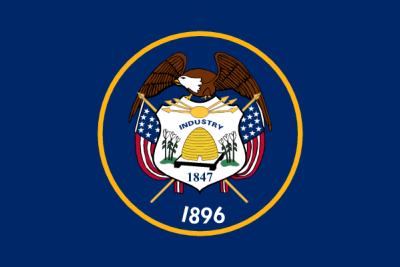Utah

Utah recognizes a right to prevent the appropriation of one’s name or likeness under a common law privacy-based action. The state also provides a civil and criminal cause of action when a person’s identity is used in an advertisement, but only when the use suggests approval or endorsement.
Statute
YES
Utah provides both civil and criminal penalties for publishing an advertisement in which the personal identity of an “individual is used in a manner which expresses or implies” approval or endorsement.
Utah first passed a misappropriation statute in 1909 that largely tracked New York’s privacy law. The law made it a criminal offense to use a person’s name, portrait or picture for “advertising purposes, or for purposes of trade, or upon any postal card.” Repealed 1909 Law. The current Abuse of Personal Identity Act, passed in 1981, replaces the prior criminal and civil statues with a version that greatly limits the claim within Utah. It eliminates post-mortem claims and restricts liability to instances in which there is an implication of approval or endorsement.
Common Law - Right of Publicity
UNCLEAR
At least one federal court has held that Utah has a common law right of publicity and that it is not preempted by the state’s Abuse of Personal Identity Act. The statute expressly states that it does “not limit or supersede any causes of action otherwise available to the parties.” This provision, however, has not yet been interpreted by state courts in the context of deciding whether a common law right of publicity exists.
Nature’s Way Prods. v. Nature-Pharma, Inc., 736 F. Supp.245 (D. Utah 1990)
Common Law - Right of Privacy-Appropriation Tort
YES
Utah recognizes a right to privacy, and the appropriation branch of the tort. It has adopted the Restatement (Second) of Torts articulation of the claim. Lower courts have specifically explained that to make a claim under Utah law a plaintiff must establish three elements: (1) appropriation; (2) of another’s name or likeness that has some “intrinsic value”; (3) for the use or benefit of the defendant.
Cox v. Hatch, 761 P.2d 556 (Utah 1988)
Post-Mortem Right
UNCLEAR
At least one federal court has held that Utah’s common law right of publicity would survive death. The current statute, however, does not provide protection for post-mortem rights, although earlier versions of the statute did.
Nature’s Way Prods. v. Nature-Pharma, Inc., 736 F. Supp.245 (D. Utah 1990)
Limits on Right
Does the law require the plaintiff or identity-holder to be a celebrity or have a commercially valuable identity?
LIKELY YES
Under the common law action, the Utah Supreme Court has expressly required plaintiffs’ identities to have some kind of “intrinsic value.”
Cox v. Hatch, 761 P.2d 556 (Utah 1988)
Does the law protect persona?
LIKELY NO
A Utah appellate court rejected a privacy-based appropriation claim when the plaintiff was referred to, but neither her name nor likeness was used. The statute expressly defines “personal identity” as limited to the use of a person’s “name, title, picture or portrait.”
Stein v. Marriott Ownership Resorts, Inc., 944 P.2d 374 (Utah Ct. App. 1997)
Is Liability Limited to Uses on Commercial Advertising or Commercial Speech?
NO
The Utah Supreme Court has expressly held that both the statutory right to protect one’s identity and the common law appropriation tort are not limited to commercial speech, even though the statutory right is limited to the advertising context.
“Advertisements” under the statute, however, are broadly defined to include any “notice designed to attract public attention or patronage and includes a list of supporters for a particular cause.” The Utah Supreme Court interpreting an earlier version of the civil claim construed the then present language “for purposes of trade” narrowly as excluding motion pictures and largely limiting the claim to uses in advertising or promotion of collateral commodities. Donahue v. Warner Bros. Pics., 272 P.2d 177 (Utah 1954). Subsequent courts, however, have allowed claims against television stations for spots that appear directed at increasing viewership. Jeppson v. United Television, Inc., 580 P.2d 1087 (Utah. 1978). Both of these cases were decided under statutes with very different texts than the current one and the current statute is much narrower.
Cox v. Hatch, 761 P.2d 556 (Utah 1988)
Statutory Defenses
The statute does not contain exceptions.
First Amendment Analysis
The Utah Supreme Court has considered a First Amendment defense to both its appropriation privacy-based tort and its right of publicity statute and concluded that the First Amendment prohibits liability for the use of photographs taken in a public place with public officials or candidates. Utah sits in the Tenth Circuit Court of Appeals, which has applied a balancing test to determining the scope of the First Amendment defense in the context of right of publicity claims.
Cox v. Hatch, 761 P.2d 556 (Utah 1988)
Cardtoons, L.C. v. Major League Baseball Players Ass’n, 95 F.3d 959 (10th Cir. 1996) (considering Oklahoma statutory right of publicity)
Other Commentary
- Utah has also recognized the incidental use exception to appropriation and statutory claims
Cox v. Hatch, 761 P.2d 556 (Utah 1988) - The Abuse of Personal Identity Act provides for publisher liability if a “reasonable person would conclude that it is unlikely than an individual” would have consented to the use.
Utah Code §45-3-5 - The criminal penalty requires an apology or retraction after a conviction.
Utah Code § 76-9-407
